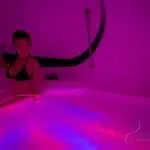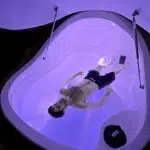I’ve never been described as a “sound sleeper.” Even in high school, I was the last to turn out the lights each night and the first to shuffle out of bed in the morning, making a fresh pot of coffee in a misguided attempt to replace the hours of sleep I consistently lacked.
I hadn’t mentioned my tenuous history with my pillow when I was first introduced to float therapy by Mandy Rowe, a member of the True REST team. I was intrigued by float therapy for a number of reasons, but I hadn’t considered the effects on my sleep patterns until after my first session. Feeling refreshed and content as we left the spa that day, Mandy casually turned to me and said, “Enjoy your evening! I’m sure you’ll sleep well tonight.”
I slept for 10 hours.
In fact, planning for an extended night of sleep has become part of my own personal floating practice; even after a morning session, my eyelids start to feel heavy by the afternoon. I consistently fall asleep within a few hours of floating and wake up feeling more rested than after an average night of sleep – a welcomed benefit, but one that requires a flexible post-float agenda.
Through changing seasons, new homes, and a fervent attempt to improve my bedroom’s feng shui, my own struggle with Mr. Sandman knows no bounds, but float therapy has been its kryptonite. I shouldn’t be surprised – many sleep disorders (including the mild insomnia I’ve experienced) are correlated with stress and anxiety, natural enemies of the deep relaxation experienced during float therapy.
Research proves that floating delivers a one-two punch when it comes to most sleep disorders. First, an extended period of deep relaxation combats the mental pressure of an anxious mind. By easing into the meditative mindset of a theta brainwave state, nagging thoughts naturally melt away.
Simultaneously, float therapy alleviates our bodies’ physical stress cues. Magnesium sulfate, the mineral compound that makes up Epsom salt, is easily absorbed through the skin during a float session and put to work through our blood stream. When working together, magnesium sulfate maintains the basics: blood pressure, breathing, and hearth rhythm. Additionally, a single float session significantly reduces levels of cortisol, the “stress hormone.”
The takeaway: Stress is no match for an hour in a Float Pod. By moderating both the mental and physical symptoms of stress, floating perfectly primes our mind, body, and spirit for sleep.
Unfortunately, the summer months add an extra factor the sleep equation. Sleep clinics report an uptick in patients experiencing insomnia as temperatures rise. Why? Blame those long, lazy summer days; heat and longer daylight hours may be good for a day at the beach, but they’re natural enemies to a restful night of sleep.
Find yourself counting ceiling tiles until the wee hours? Here’s how to float your way to a good night’s sleep this summer:
- Cool It: Before your float, prep your bedroom. Set the air conditioner, place fans, or purchase a mobile A/C unit to keep your sleep space cool through the night. When you come home, rinse off in a cool shower to avoid fluctuations in body temperature.
- Cut the Lights: Banish TVs, phones, and tablets from the bedroom – the glow from modern electronics can throw off the body’s natural circadian rhythm. To maximize the benefits of your float, utilize a relaxation technique to ease your body into sleep.
- Schedule Strategically: Lean into the long summer days with a late afternoon or evening float. Rather than fighting against a late-setting sun, schedule a session that will place your bedtime a little after sunset (make sure to leave time to wind-down when you get home). By timing your float session based on the season, sunrise will feel more like a refreshing alarm clock and less like a rude awakening.


